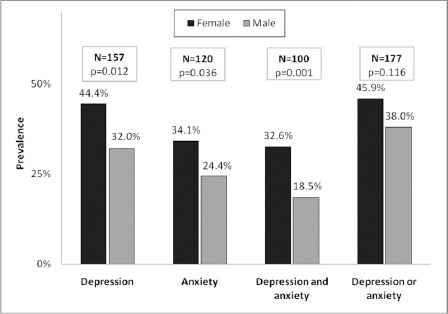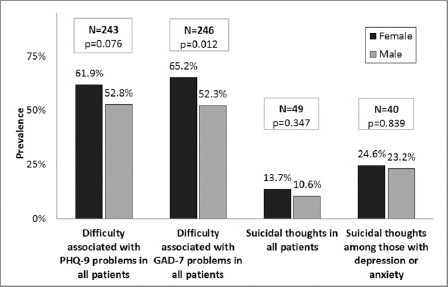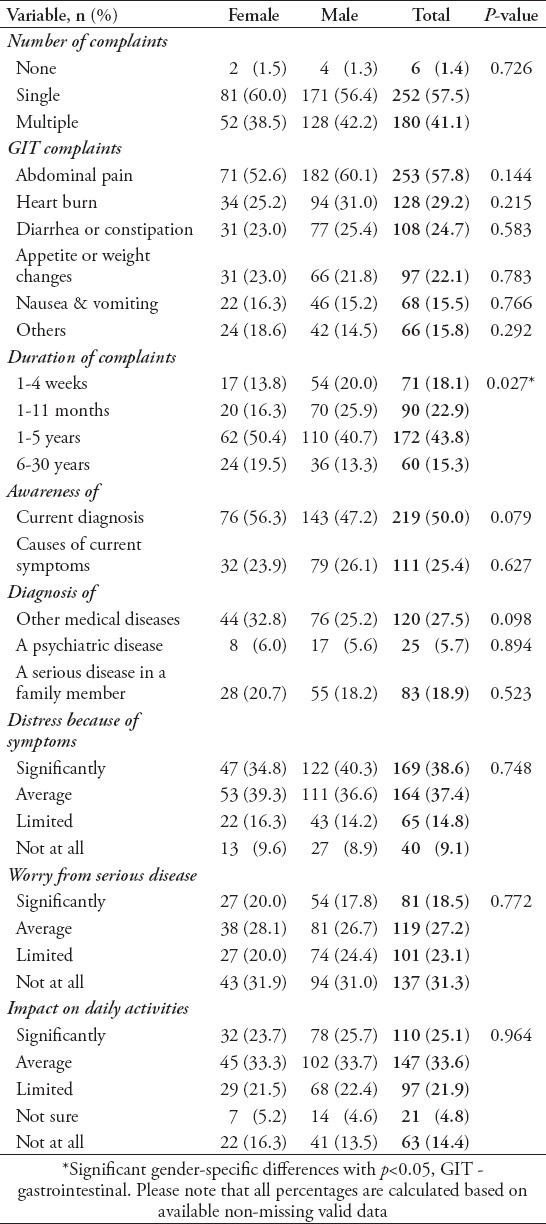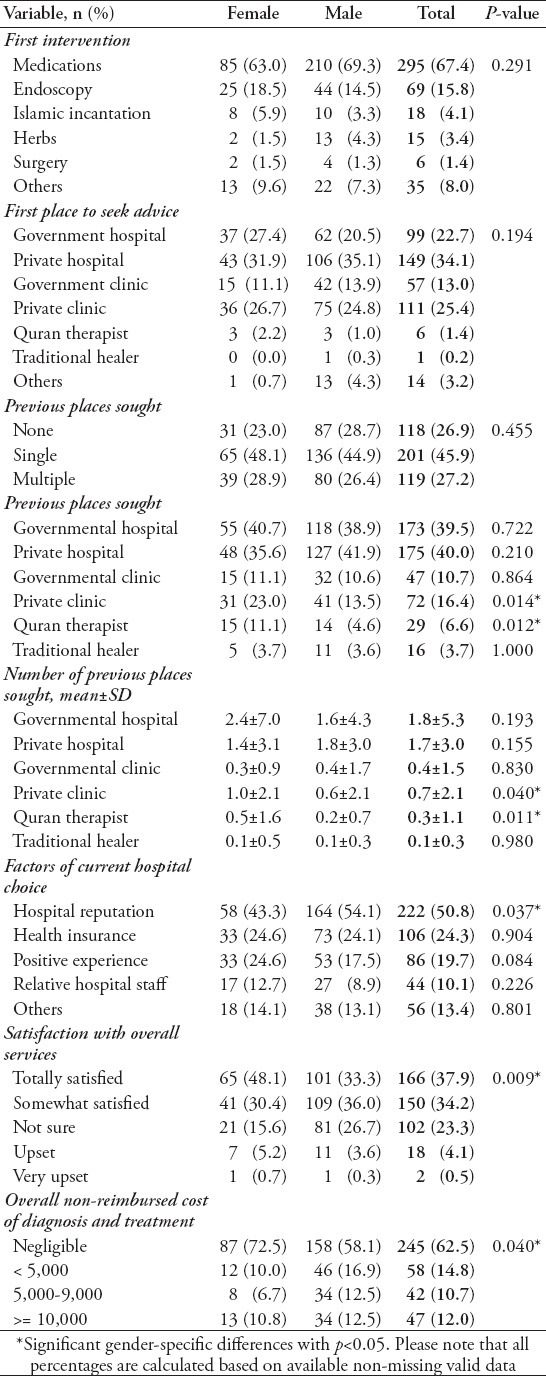Abstract
Objectives:
To evaluate the gender-specific difference in the prevalence of depression and anxiety and the help-seeking behavior among gastroenterology outpatients.
Methods:
A cross-sectional study was carried out in gastroenterology clinics in 4 hospitals in Riyadh, Saudi Arabia between February and September 2013. A self-administrated questionnaire was developed and administered to patients. The Patient Health Questionnaire (PHQ-9) and Generalized Anxiety Disorder (GAD-7) questionnaires were used to identify depression and anxiety.
Results:
A total of 438 patients completed the study questionnaire; 135 (31%) females, and 303 (69%) males. Compared with males, females had more depression symptoms (44% versus 32%, p=0.012), anxiety symptoms (34% versus 24%, p=0.036), anxiety-associated difficulty (65% versus 52%, p=0.012), but similar suicidal thoughts (14% versus 11%, p=0.347). Females had similar gastrointestinal complaints but longer duration of symptoms. In both females and males, the most common first interventions were using medications (63% versus 69%), and undergoing endoscopy (19% versus 15%), while very few patients initially used herbs or Islamic incantation “Roquia” (7% versus 8%). Compared with males, females were more likely to subsequently seek help at private clinics (23% versus 14%, p=0.014), or with a Quran therapist (11% versus 5%, p=0.012).
Conclusion:
There are clear gender-specific differences in depression and anxiety symptoms and associated perceived difficulty, but modest differences in help-seeking behavior. Female patients at the gastroenterology clinic may deserve more psychological attention to diagnose depression and anxiety and to alleviate their impact.
Psychiatric disorders including depression and anxiety have been reported more frequently among females than male patients.1,2 Additionally, depression and anxiety in woman may be associated with increased symptom severity, chronic course, and functional impairment compared with men.3,4 Gender-specific differences in psychological, neurochemical, anatomic, hormonal, genetic, and personality factors have been suggested to explain the gender-specific difference in lifetime prevalence of depression and anxiety.2,4 After developing a disease, the patient behavior can be as active as rapidly seeking help from available healthcare services or as passive as dismissing the symptoms.5 Help-seeking behavior can be defined as the behavior of individual patients in response to developing a disease with the aim to relieve or improve the disease experience.5 Several socio-demographic and psychosocial factors have been reported to influence timing, frequency, and type of the help-seeking behavior among patients with different health problems.6,7 It was suggested that women are more likely than men to seek medical help for their medical and mental problems, but less likely to seek medical help for alcohol problems.8,9 A limited number of studies examined the help-seeking behavior among patients with gastrointestinal symptoms, and did not show a gender-specific difference.10,11 In Saudi Arabia, females apparently have a high burden of depression and anxiety.12,13 Local data on help-seeking behavior are limited and old.14 Additionally, there is a lack of data on any the gender-specific differences in help-seeking behavior, and in depression or anxiety, or help-seeking behavior in gastroenterology patients. The objective of the current study was to evaluate the gender-specific difference in the prevalence of depression and anxiety symptoms, and the help-seeking behavior among gastroenterology outpatients in Saudi Arabia.
Methods
Population
The current study was conducted among outpatients attending gastroenterology clinics in one of 4 hospitals in Riyadh; King Khalid University Hospital (KKUH), King Fahad Medical city (KFMC), Dallah Hospital, and Dr. Sulaiman Al-Habib Arryan Hospital. All hospitals provide gastroenterology services to their patients. Both KKUH and KFMC hospitals are governmental hospitals, while Dallah and Dr. Sulaiman Al-Habib Arryan Hospitals are private hospitals. Both adult female and male patients above the age of 18 years were included. No exclusion was based on clinical diagnosis or duration of the disease.
Study design
A cross-sectional study was carried out between February and September 2013. The study obtained all required ethical approvals from the institutional review board at the Faculty of Medicine at King Saud University, Riyadh, Saudi Arabia.
Sample size
As there is a lack of population-based, epidemiological surveys of depression and anxiety in Saudi Arabia, previous cross-sectional studies among Saudi primary care patients during the last 2 decades estimated the point-prevalence of depression at 20-40% and anxiety at 24%, with approximately 10-15% difference between females and males.12,13,15 Using the results of Backer et al13 who used the Patient Health Questionnaire (PHQ) to detect depression, we estimated that 434 patients are required to detect a 10.7% gender-specific difference in the prevalence of depression (24.9% versus 14.2%), at a 95% confidence level and 80% power.
Questionnaire
A self-administrated questionnaire was developed and administered to all participants. It included 4 sections; socio-demographic, gastrointestinal complaints, help-seeking behavior, and validated tools that measure the presence of depression and anxiety. The gastrointestinal complaints included information on number, type, and duration of complaints; awareness of diagnosis and underlying causes; associated distress and worry; and the impact on daily activities. Help-seeking behavior or behavior following gastrointestinal complaints included information about first intervention sought; type of healthcare facilities utilized, factors affecting the choice of a healthcare facility, satisfaction with services, and costs of diagnosis and treatment. These included the Arabic version of the 9-item PHQ-9 to assess the presence of depression, and the 7-item Generalized Anxiety Disorder (GAD-7) questionnaire to assess the presence of anxiety. The content of the study questionnaire was validated by experts in gastroenterology and psychiatry, to ensure the relevance and applicability of different questions. The questionnaire was then piloted on a small number of participants (N=20) before widespread distribution. The wording and suggested answers were modified for some questions based on the feedback from the pilot sample.
Recruitment
Since it is almost impossible to obtain the roster of patients covered by each hospital, the questionnaire was distributed to patients attending gastroenterology clinics at the time of the study; namely, convenience sampling. The questionnaire was distributed just before or after the clinic visit. Informed written consent was obtained from all participants after explanation of the study objectives. The participation rate was 88% of all contacted patients (440/500).
Statistical analysis
Data were presented using frequencies and percentages for categorical data and mean and standard deviation (SD) for continuous data. Scores were calculated for PHQ-9 and GAD-7 with the maximum score 27 for PHQ-9, and 21 for GAD-7. As suggested before, those who obtained a score ≥10 on PHQ-9 were considered as having symptoms suggestive of depression,16 while those who obtained a score ≥10 on GAD-7 were considered as having symptoms suggestive of anxiety.17 Significant gender-specific differences in socio-demographic characteristics, depression and anxiety symptoms, gastrointestinal complaints, and help-seeking behavior were tested using chi-square test or Fisher exact test (as appropriate) for categorical data, and student t-test or Mann-Whitney test (as appropriate) for continuous data. Gender-specific differences in depression and anxiety symptoms after adjusting for socio-demographic characteristics and gastrointestinal complaints were examined using multivariate logistic regression models. All p-values were 2-tailed, and a p-value<0.05 was considered as significant. The statistical package for social sciences (IBM SPSS Statistics for Windows, Version 20.0. Armonk, NY USA: IBM Corp) was used for all statistical analyses.
Results
Socio-demographic characteristics
A total of 438 patients completed the study questionnaire; 135 (31%) females, and 303 (69%) males. The socio-demographic characteristics of the study patients by gender are shown in Table 1. The average age was similar in both females and males. The majority of both females and males were Saudi. Females were less likely to be married, and more likely to be divorced or widowed. Females were less likely to have college education or higher. More than half of both females and males had a monthly household income of 10,000 SR or above. Females were more likely to be unemployed. In both genders, approximately 90% of the patients were living in Riyadh, and around two-thirds owned a house. The study patients were recruited from KKUH (155), Dallah Hospital (148), KFMC (69), and Dr. Sulaiman Al-Habib Arryan Hospital (66), with no gender-specific difference.
Table 1.
Socio-demographic characteristics by gender among outpatients attending gastroenterology clinics in 4 hospitals in Riyadh, Saudi Arabia.

Depression and anxiety symptoms
Figures 1 & 2 show the difference in the prevalence and impact of depression and anxiety symptoms by gender. Compared with males, females had more depression symptoms, anxiety symptoms, the presence of both depression and anxiety symptoms, and to a lesser extent, the presence of either depression or anxiety symptoms. Compared with males, females were more likely to report greater difficulty to manage their work, take care of things at home, or get along with other people because of the anxiety problems, and to a lesser extent because of the depression problems. However, there was no difference in suicidal thoughts between females and males in all patients, and among those with depression or anxiety. After adjusting for gender-specific differences in socio-demographic data (including age, marital status, nationality, educational level, monthly income, occupation, residence, and type of housing) and gastrointestinal complaints (including number and duration of complaints), females were 2.4 times more likely than males to have depression symptoms (odds ratio=2.4, confidence interval 1.3-4.4, p=0.005), and 1.9 times more likely than males to have anxiety symptoms (odds ratio=1.9, confidence interval 1.0-3.6, p=0.049).
Figure 1.

Prevalence of depression and anxiety symptoms by gender among outpatients attending gastroenterology clinics in 4 hospitals in Riyadh, Saudi Arabia. The PHQ-9 score ≥10 was considered as depression symptoms, and GAD-7 score ≥10 was considered as anxiety symptoms. PHQ - Patient Health Questionnaire, GAD - Generalized Anxiety Disorder
Figure 2.

Impact of depression and anxiety symptoms by gender among outpatients attending gastroenterology clinics in 4 hospitals in Riyadh, Saudi Arabia. The PHQ-9 score ≥10 was considered as depression symptoms, and GAD-7 score ≥10 was considered as anxiety symptoms. PHQ - Patient Health Questionnaire. GAD - Generalized Anxiety Disorder
Gastrointestinal complaints
Table 2 shows the gastrointestinal complaints among the study patients by gender. Those who had multiple complaints were similar in females and males. The most commonly reported complaints were similar in both females and males. They included abdominal pain, heartburn, diarrhea or constipation, and appetite or weight changes. However, females were more likely to report longer duration of symptoms, for example, symptoms lasting a year, or more represented 70% in females compared with 54% in males (p=0.027). Compared with males, females were slightly more aware of their gastrointestinal diagnosis, but similarly less aware of the reasons behind their symptoms. Compared with males, females had slightly more medical comorbidity, but similar diagnosis of psychiatric diseases and diagnosis of serious diseases in family members. Both females and males reported similarly significant distress from their symptoms, significant worry from having serious disease causing their symptoms, and significant negative impact of the symptoms on their daily activities.
Table 2.
Gastrointestinal complaints by gender among outpatients attending gastroenterology clinics in 4 hospitals in Riyadh, Saudi Arabia.

Help-seeking behavior
The gender-specific help-seeking behavior of the study patients following gastrointestinal complaints is shown in Table 3. In both females and males, the most common first interventions (diagnostic or therapeutic) following gastrointestinal complaints were using medications, and undergoing endoscopy, while very few patients initially used herbs or Islamic incantation “Roquia”. In both females and males, the first intervention was carried out primarily in private hospitals and clinics more than government hospitals and clinics. Compared with males, females were more likely to subsequently seek help following gastrointestinal complaints at private clinics and Quran therapist. Similarly, females had a higher number of visits to private clinics and Quran therapist than males. Although hospital reputation was the main factor behind choosing a hospital or a clinic in both females and males, the influence of this factor was lower in females than males. On the other hand, the effect of previous positive experience tended to be higher in females than males. Compared with males, females were more likely to be totally satisfied with services received in these hospitals, and less likely to spend money on the diagnosis and treatment of their symptoms.
Table 3.
Help-seeking behavior following gastrointestinal complaints by gender among outpatients attending gastroenterology clinics in 4 hospitals in Riyadh, Saudi Arabia.

Discussion
We are reporting clear gender-specific differences in the burden of depression and anxiety symptoms, and modest gender-specific differences in the help-seeking behavior among gastroenterology outpatients recruited from 4 hospitals in Riyadh, Saudi Arabia. Females in the current study represented less than one-third of the studied patients. Since we did not have any gender-specific or complaint-related exclusion, this finding may indicate a lower likelihood of women seeking help at gastroenterology clinics. Male predominance in using primary healthcare services has been reported before in Saudi Arabia.18,19 It was suggested that logistic issues and choosy behavior of many women who prefer a female treating physician with the same religion may at least partially explain such findings.19,20 The female low utilization in the current study is contradictory to a number of international studies that showed higher female utilization of non-gender-specific healthcare services.8,9 However, a number of studies failed to detect such gender-specific differences,10,21 and others attributed the observed gender-specific differences in help-seeking behavior to differences in the morbidity burden (specially of minor degree),22 or differences in perceived ability and willingness to seek help.23
Females in the current study had a higher burden of both depression and anxiety, even after adjusting for socio-demographic characteristics and gastrointestinal complaints. While gender-specific difference in depression and anxiety was not the focus of previous local cross-sectional studies, females in these studies consistently had a 10-15% higher point-prevalence of both depression and anxiety compared with males.12,13,15 Although, comparison is challenging because of the difference in tools used to assess depression symptoms12,15 and the age of the patients examined,12,15 the above figures were consistent with the 10-12% gender-specific difference observed in the current study. Additionally, a meta-analysis of 3 studies estimating depression among mainly Saudi adult patients in primary care setting found that males have a 35% lower risk of depression than females.24 Internationally, the majority,25,26 but not all27 of the few studies that examined the gender-specific differences in depression and/or anxiety among patients with gastrointestinal complaints reported higher female burden. The greater difficulty associated with anxiety and depression symptoms reported by females in the current study may reflect their more perceived social stress, and lower coping abilities.28 The suicidal thoughts that were similar in both females and males in the current study were lower than in Western countries,29 probably because suicide is absolutely prohibited in Islamic culture.30 Previous studies were inconsistent with regards to the gender-specific differences in suicidal thoughts among those with depression and/or anxiety.25,29,31
There were no gender-specific differences in the initial help-seeking behavior following gastrointestinal complaints as regards to the type of intervention used, or the provider sought. However, modest differences were observed in subsequent help-seeking behavior, especially as regards to female preference to private clinics and Quran therapists. The similar initial help-seeking behavior observed in the current study may reflect the similar number and types of gastrointestinal complaints. It was suggested that preference of same-gender physician my direct Saudi patients towards the private sector.32 Previous studies found that Saudi females use traditional healing modalities including the Quran more frequently than males.33,34 Data on gender-specific differences in help-seeking behavior among patients with gastrointestinal complaints is very limited internationally, and completely lacking in Saudi Arabia. Herschbach and colleagues10 found that the duration of symptoms and comorbid psychological disorders, but not gender, were predictors for the frequency of physician consultations among patients with functional gastrointestinal disorders.
The current study has many advantages; bridging the local knowledge gap in gender-specific differences in help-seeking behavior and depression and anxiety symptoms by surveying a sufficiently large number of patients from both private and governmental sectors. Nevertheless, we acknowledged a number of limitations, being a convenience sample; the results should be generalized with caution and should not be regarded as representative to Saudi gastroenterology patients. Being a self-reported study, the possibility of recall bias cannot be excluded. Finally, using self-rated scales to diagnose depression and anxiety may be less accurate compared with diagnostic interview conducted by a health care professional. However, these scales are well validated and easier to implement in a busy gastroenterology clinic.
In conclusion, we are reporting clear gender-specific differences in depression and anxiety symptoms and associated perceived difficulty, but modest differences in help-seeking behavior. Female patients attending the gastroenterology clinic may deserve more psychological attention to diagnose depression and anxiety and to alleviate their impact.
Acknowledgments
The authors would like to acknowledge the support from the College of Medicine Research Center, Deanship of Scientific Research, King Saud University. We thank our collaborators at King Khalid University Hospital, King Fahad Medical City, Dallah Hospital, and Dr. Sulaiman Al-Habib Arryan Hospital, and express gratitude to Dr. Aiman El-Saed (Asst. Professor of Epidemiology & Biostatistics) for his help in data analysis.
References
- 1.Abate KH. Gender disparity in prevalence of depression among patient population: a systematic review. Ethiop J Health Sci. 2013;23:283–288. doi: 10.4314/ejhs.v23i3.11. [DOI] [PMC free article] [PubMed] [Google Scholar]
- 2.Donner NC, Lowry CA. Sex differences in anxiety and emotional behavior. Pflugers Arch. 2013;465:601–626. doi: 10.1007/s00424-013-1271-7. [DOI] [PMC free article] [PubMed] [Google Scholar]
- 3.Kinrys G, Wygant LE. [Anxiety disorders in women: does gender matter to treatment?] Rev Bras Psiquiatr. 2005;27(Suppl 2):S43–S50. doi: 10.1590/s1516-44462005000600003. [DOI] [PubMed] [Google Scholar]
- 4.Grigoriadis S, Robinson GE. Gender issues in depression. Ann Clin Psychiatry. 2007;19:247–255. doi: 10.1080/10401230701653294. [DOI] [PubMed] [Google Scholar]
- 5.McQueen DV. Illness and sick-role behavior. In: Breslow L, editor. Encyclopedia of public health. Vol. 2. New York (NY): Gale Group; 2002. [Accessed 2014 June 04]. Available from: http://www.encyclopedia.com/doc/1G2-3404000445.html . [Google Scholar]
- 6.Parslow R, Jorm A, Christensen H, Jacomb P, Rodgers B. Gender differences in factors affecting use of health services: an analysis of a community study of middle-aged and older Australians. Soc Sci Med. 2004;59:2121–2129. doi: 10.1016/j.socscimed.2004.03.018. [DOI] [PubMed] [Google Scholar]
- 7.Shaw C. A review of the psychosocial predictors of help-seeking behaviour and impact on quality of life in people with urinary incontinence. J Clin Nurs. 2001;10:15–24. doi: 10.1046/j.1365-2702.2001.00443.x. [DOI] [PubMed] [Google Scholar]
- 8.Levinson D, Ifrah A. The robustness of the gender effect on help seeking for mental health needs in three subcultures in Israel. Soc Psychiatry Psychiatr Epidemiol. 2010;45:337–344. doi: 10.1007/s00127-009-0079-4. [DOI] [PubMed] [Google Scholar]
- 9.Ladwig KH, Marten-Mittag B, Formanek B, Dammann G. Gender differences of symptom reporting and medical health care utilization in the German population. Eur J Epidemiol. 2000;16:511–518. doi: 10.1023/a:1007629920752. [DOI] [PubMed] [Google Scholar]
- 10.Herschbach P, Henrich G, von Rad M. Psychological factors in functional gastrointestinal disorders: characteristics of the disorder or of the illness behavior? Psychosom Med. 1999;61:148–153. doi: 10.1097/00006842-199903000-00005. [DOI] [PubMed] [Google Scholar]
- 11.Ringstrom G, Abrahamsson H, Strid H, Simren M. Why do subjects with irritable bowel syndrome seek health care for their symptoms? Scand J Gastroenterol. 2007;42:1194–1203. doi: 10.1080/00365520701320455. [DOI] [PubMed] [Google Scholar]
- 12.Al-Shammari SA, Al-Subaie A. Prevalence and correlates of depression among Saudi elderly. Int J Geriatr Psychiatry. 1999;14:739–747. doi: 10.1002/(sici)1099-1166(199909)14:9<739::aid-gps998>3.0.co;2-1. [DOI] [PubMed] [Google Scholar]
- 13.Becker S, Al Zaid K, Al Faris E. Screening for somatization and depression in Saudi Arabia: a validation study of the PHQ in primary care. Int J Psychiatry Med. 2002;32:271–283. doi: 10.2190/XTDD-8L18-P9E0-JYRV. [DOI] [PubMed] [Google Scholar]
- 14.al-Shammari SA. Help-seeking behavior of adults with health problems in Saudi Arabia. Fam Pract Res J. 1992;12:75–82. [PubMed] [Google Scholar]
- 15.Shehatah A, Rabie MA, Al-Shahry A. Prevalence and correlates of depressive disorders in elderly with type 2 diabetes in primary health care settings. J Affect Disord. 2010;123:197–201. doi: 10.1016/j.jad.2009.09.002. [DOI] [PubMed] [Google Scholar]
- 16.Gilbody S, Richards D, Brealey S, Hewitt C. Screening for depression in medical settings with the Patient Health Questionnaire (PHQ): a diagnostic meta-analysis. J Gen Intern Med. 2007;22:1596–1602. doi: 10.1007/s11606-007-0333-y. [DOI] [PMC free article] [PubMed] [Google Scholar]
- 17.Spitzer RL, Kroenke K, Williams JB, Lowe B. A brief measure for assessing generalized anxiety disorder: the GAD-7. Arch Intern Med. 2006;166:1092–1097. doi: 10.1001/archinte.166.10.1092. [DOI] [PubMed] [Google Scholar]
- 18.Al-Eissa EI. The morbidity pattern among adolescents visiting primary health care centers. Saudi Med J. 2000;21:934–937. [PubMed] [Google Scholar]
- 19.Saeed AA, Mohamed BA. Patients’ perspective on factors affecting utilization of primary health care centers in Riyadh, Saudi Arabia. Saudi Med J. 2002;23:1237–1242. [PubMed] [Google Scholar]
- 20.al-Doghaither AH, Abdelrhman BM, Saeed AA, Magzoub ME. Factors influencing patient choice of hospitals in Riyadh, Saudi Arabia. J R Soc Promot Health. 2003;123:105–109. doi: 10.1177/146642400312300215. [DOI] [PubMed] [Google Scholar]
- 21.Tedstone Doherty D, Kartalova-O’Doherty Y. Gender and self-reported mental health problems: predictors of help seeking from a general practitioner. Br J Health Psychol. 2010;15:213–228. doi: 10.1348/135910709X457423. [DOI] [PMC free article] [PubMed] [Google Scholar]
- 22.Koopmans GT, Lamers LM. Gender and health care utilization: the role of mental distress and help-seeking propensity. Soc Sci Med. 2007;64:1216–1230. doi: 10.1016/j.socscimed.2006.11.018. [DOI] [PubMed] [Google Scholar]
- 23.Mackenzie CS, Gekoski WL, Knox VJ. Age, gender, and the underutilization of mental health services: the influence of help-seeking attitudes. Aging Ment Health. 2006;10:574–582. doi: 10.1080/13607860600641200. [DOI] [PubMed] [Google Scholar]
- 24.Alibrahim OA, Al-Sadat N, Elawad NAM. Gender and risk of depression in Saudi Arabia, a systematic review and meta-analysis. Journal of Public Health in Africa. 2010;1:1. doi: 10.4081/jphia.2010.e7. [DOI] [PMC free article] [PubMed] [Google Scholar]
- 25.Li XJ, He YL, Ma H, Liu ZN, Jia FJ, Zhang L. Prevalence of depressive and anxiety disorders in Chinese gastroenterological outpatients. World J Gastroenterol. 2012;18:2561–2568. doi: 10.3748/wjg.v18.i20.2561. [DOI] [PMC free article] [PubMed] [Google Scholar]
- 26.Haug TT, Mykletun A, Dahl AA. Are anxiety and depression related to gastrointestinal symptoms in the general population? Scand J Gastroenterol. 2002;37:294–298. doi: 10.1080/003655202317284192. [DOI] [PubMed] [Google Scholar]
- 27.Jiang RH, Yu X, Ma H, He YL, Wei J, Bai WP, et al. [The prevalence of depression and anxiety in gastrointestinal out-patients of tertiary general hospitals in Beijing] Zhonghua Nei Ke Za Zhi. 2009;48:399–401. [PubMed] [Google Scholar]
- 28.Calvete E, Camara M, Estevez A, Villardon L. The role of coping with social stressors in the development of depressive symptoms: gender differences. Anxiety Stress Coping. 2011;24:387–406. doi: 10.1080/10615806.2010.515982. [DOI] [PubMed] [Google Scholar]
- 29.Vannoy SD, Robins LS. Suicide-related discussions with depressed primary care patients in the USA: gender and quality gaps. A mixed methods analysis. BMJ Open. 2011;1:e000198. doi: 10.1136/bmjopen-2011-000198. [DOI] [PMC free article] [PubMed] [Google Scholar]
- 30.Shah A, Chandia M. The relationship between suicide and Islam: a cross-national study. J Inj Violence Res. 2010;2:93–97. doi: 10.5249/jivr.v2i2.60. [DOI] [PMC free article] [PubMed] [Google Scholar]
- 31.Al-Habeeb AA, Sherra KS, Al-Sharqi AM, Qureshi NA. Assessment of suicidal and self-injurious behaviours among patients with depression. Eastern Mediterr Health J. 2013;19:248–254. [PubMed] [Google Scholar]
- 32.Al-Omar BA, Saeed KS. Factors influencing patients’ utilization of primary health care providers in Saudi Arabia. J Family Community Med. 1998;5:23–30. [PMC free article] [PubMed] [Google Scholar]
- 33.Al-Faris EA, Al-Rowais N, Mohamed AG, Al-Rukban MO, Al-Kurdi A, Balla Al-Noor MA, et al. Prevalence and pattern of alternative medicine use: the results of a household survey. Ann Saudi Med. 2008;28:4–10. doi: 10.5144/0256-4947.2008.4. [DOI] [PMC free article] [PubMed] [Google Scholar]
- 34.Al-Rowais N, Al-Faris E, Mohammad AG, Al-Rukban M, Abdulghani HM. Traditional healers in Riyadh region: reasons and health problems for seeking their advice. A household survey. J Altern Complement Med. 2010;16:199–204. doi: 10.1089/acm.2009.0283. [DOI] [PMC free article] [PubMed] [Google Scholar]


